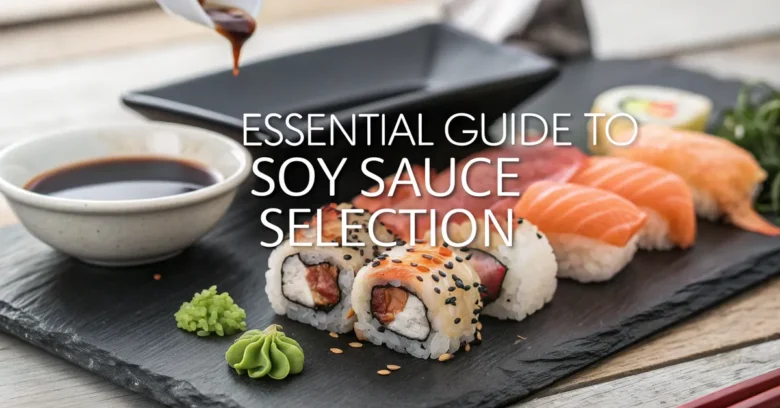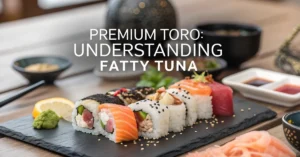Soy sauce. That dark, savory liquid is more than just a condiment; it’s the backbone of countless dishes, especially in the world of sushi. But have you ever stood in the store, overwhelmed by the sheer number of soy sauce options? It’s time to demystify that aisle. This guide will break down everything you need to know to select the right soy sauce, from understanding different types to pairing them with your favorite sushi.
The World of Soy Sauce: More Than Just One Flavor
Soy sauce might seem like a simple ingredient, but it’s actually quite complex. The flavor profiles vary wildly depending on the production method and the ingredients used. Knowing these differences is key to elevating your sushi experience.
What is Soy Sauce, Anyway?
At its heart, soy sauce is a fermented product. Traditionally, it’s made from:
- Soybeans: The base, providing protein and umami.
- Wheat: Adds sweetness and complexity.
- Salt: Controls fermentation and acts as a preservative.
- Water: The medium for the entire process.
- Koji (Aspergillus): A type of mold that kicks off fermentation.
These simple ingredients transform over time into a rich, flavorful liquid thanks to the magic of fermentation. The length of fermentation, the ratio of ingredients, and even the climate can all impact the final product.
The Main Types of Soy Sauce
The Japanese Agricultural Standard (JAS) classifies Japanese soy sauce, or shoyu, into five main types. Each brings something unique to the table:
- Koikuchi (Dark Soy Sauce): The most common type in Japan, accounting for about 80% of the market. It’s made with roughly equal parts soybeans and wheat. Its flavor is balanced with salty, sweet, and umami notes.
- Usukuchi (Light Soy Sauce): Lighter in color and saltier than koikuchi. It’s often used in cooking to add flavor without darkening the dish. Despite the name, it doesn’t necessarily have fewer calories or less sodium; it just tastes saltier.
- Tamari: Traditionally made without wheat (or with very little). It’s often considered gluten-free, though always check the label. Tamari tends to have a richer, less sweet flavor than koikuchi.
- Saishikomi (Twice-Brewed Soy Sauce): Instead of brine, this type is brewed with koikuchi soy sauce. It results in a darker, richer, and less salty flavor profile.
- Shiro (White Soy Sauce): Made with mostly wheat and very little soybeans. It has a very light color and a subtly sweet flavor. It’s often used in delicate dishes where you want to add flavor without changing the color.
Outside of Japan, you’ll also encounter Chinese soy sauces, which generally fall into two categories:
- Light Soy Sauce (Sheng Chou): Similar to usukuchi, it’s saltier and thinner than dark soy sauce.
- Dark Soy Sauce (Lao Chou): Often aged longer and sometimes has molasses or sugar added. It’s darker, thicker, and sweeter than light soy sauce.
How They’re Made: Traditional vs. Modern
The way soy sauce is made also affects its character. There are two main approaches:
- Traditionally Brewed: This method uses the koji mold to ferment soybeans and wheat over several months (or even years). The result is a complex flavor profile with layers of umami, sweetness, and saltiness.
- Chemically Produced: This is a faster, cheaper method using hydrolyzed soy protein. The flavor is less complex and often requires additives to mimic the taste of traditionally brewed soy sauce.
Decoding the Label: What to Look For
Navigating the soy sauce aisle can feel like deciphering a foreign language. Here’s a breakdown of key terms and phrases to help you make informed choices.
Understanding Common Terms
- Naturally Brewed: This indicates that the soy sauce was made using the traditional fermentation method. It’s a sign of quality.
- Hydrolyzed Soy Protein: This signals that the soy sauce was chemically produced.
- Gluten-Free: This is important for those with gluten sensitivities. Tamari is often gluten-free, but it’s essential to check the label to be sure.
- Reduced Sodium: Soy sauce is naturally high in sodium. Reduced sodium versions are available, but they may have a different flavor profile.
- Organic: This means the soybeans and wheat used were grown without synthetic pesticides or fertilizers.
Ingredient List: Quality Starts Here
The ingredient list is your first clue about the quality of the soy sauce. Look for:
- Simple Ingredients: Ideally, the list should include just soybeans, wheat, salt, and water. Some may include koji or other natural starters.
- Avoid Additives: Be wary of ingredients like caramel color, corn syrup, or MSG, which are often added to chemically produced soy sauces to enhance their flavor and appearance.
Sodium Content: A Salty Situation
Soy sauce is inherently salty. However, the sodium content can vary significantly between brands and types.
- Check the Label: Pay attention to the sodium content per serving. This information is usually listed on the nutrition facts panel.
- Consider Reduced Sodium Options: If you’re watching your sodium intake, reduced sodium soy sauce can be a good option. Keep in mind that the flavor may be slightly different.
Color and Clarity: A Visual Guide
The appearance of soy sauce can also tell you something about its quality.
- Naturally Brewed: Typically has a rich, reddish-brown color and is clear.
- Chemically Produced: May be darker and less clear, sometimes with a murky appearance.
Tasting Notes: Unlocking the Flavor Profile
Soy sauce isn’t just salty. Good quality soy sauce should have a complex flavor profile that includes:
- Umami: That savory, meaty flavor that’s so satisfying.
- Sweetness: A subtle sweetness that balances the saltiness.
- Saltiness: The primary flavor, but it shouldn’t be overpowering.
- Acidity: A slight tang that adds complexity.
- Bitterness: A hint of bitterness can add depth, but it shouldn’t be harsh.
How to Taste Soy Sauce
To truly appreciate the nuances of different soy sauces, try tasting them side-by-side.
- Pour a small amount of each soy sauce into separate dishes.
- Observe the color and clarity.
- Swirl the soy sauce in the dish and inhale the aroma.
- Take a small sip and let it coat your tongue.
- Pay attention to the different flavors and how they evolve over time.
Factors Affecting Flavor
Many factors can impact the final flavor of soy sauce. Here are a few main points:
- Fermentation Time: Longer fermentation generally leads to a more complex and flavorful soy sauce.
- Soybean to Wheat Ratio: Different ratios affect the sweetness, saltiness, and umami.
- Water Quality: The type of water used can also impact the flavor.
- Climate: Temperature and humidity during fermentation can also play a role.
Pairing Soy Sauce with Sushi: A Flavorful Harmony
The right soy sauce can elevate your sushi experience. Here’s how to choose the best option for different types of sushi:
General Guidelines
- Delicate Fish: For mild-flavored fish like flounder or sea bream, a lighter soy sauce like usukuchi or shiro won’t overpower the flavor.
- Rich Fish: For fatty fish like tuna or salmon, a more robust soy sauce like koikuchi or tamari can stand up to the richness.
- Sushi Rolls: For rolls with multiple ingredients, koikuchi is a good all-around choice.
- Nigiri: With nigiri, you want to taste the fish, so use a lighter touch with the soy sauce.
Specific Recommendations
- Tuna (Maguro): Koikuchi or tamari
- Salmon (Sake): Koikuchi or saishikomi
- Yellowtail (Hamachi): Koikuchi or usukuchi
- Sea Bream (Tai): Usukuchi or shiro
- Eel (Unagi): The eel is already glazed with a sweet sauce, so you might want to skip the soy sauce altogether, or use a very light touch of usukuchi.
- Egg (Tamago): Shiro can complement the sweetness of the egg.
Dipping Etiquette: Less is More
When dipping sushi in soy sauce, remember that less is more.
- Dip Fish-Side Down: This ensures that the fish, not the rice, absorbs the soy sauce. Over-soaking the rice can make it mushy and ruin the texture.
- Don’t Mix Wasabi into the Soy Sauce: This is generally frowned upon in Japan. Instead, place a small amount of wasabi directly on the fish.
Beyond Dipping: Using Soy Sauce in Sushi Preparation
Soy sauce isn’t just for dipping. It can also be used to enhance the flavor of sushi rice and other ingredients.
Soy Sauce in Sushi Rice
A touch of soy sauce can add depth and umami to sushi rice.
- Add to the Sushi Vinegar: Mix a small amount of soy sauce into the sushi vinegar before adding it to the cooked rice.
- Use Sparingly: You don’t want the rice to be too salty or dark in color. A teaspoon or two of soy sauce per cup of uncooked rice is usually sufficient.
Marinating Fish
Soy sauce can also be used to marinate fish before using it in sushi.
- Quick Marinade: A quick marinade of soy sauce, sake, and mirin can enhance the flavor of fish like tuna or salmon.
- Don’t Over-Marinate: Marinating for too long can make the fish too salty and change its texture. Aim for 15-30 minutes.
Making Nikiri
Nikiri is a sweetened soy sauce glaze often used by sushi chefs to enhance the flavor of nigiri.
- Ingredients: Soy sauce, mirin, and sake.
- Preparation: Heat the ingredients in a saucepan until slightly thickened. Let cool before using.
- Application: Brush a thin layer of nikiri onto the fish before serving.
Storing Soy Sauce: Keeping it Fresh
Proper storage is essential to maintain the quality and flavor of your soy sauce.
How to Store Open Bottles
- Refrigerate After Opening: This is especially important for naturally brewed soy sauces, which can oxidize and lose flavor over time.
- Use an Airtight Container: An airtight container will help prevent oxidation and keep the soy sauce fresh.
- Store in a Cool, Dark Place: Avoid storing soy sauce in direct sunlight or near heat, as this can also affect its flavor.
Shelf Life: How Long Does it Last?
- Unopened: Soy sauce can last for several years if stored properly in a cool, dark place.
- Opened: Once opened, naturally brewed soy sauce will last for about a year in the refrigerator. Chemically produced soy sauce may last longer due to the preservatives it contains.
Signs of Spoilage: When to Toss It
- Changes in Color: If the soy sauce becomes significantly darker or develops a cloudy appearance, it may be spoiled.
- Changes in Aroma: A sour or off-putting smell is a sign that the soy sauce has gone bad.
- Changes in Flavor: If the soy sauce tastes noticeably different (e.g., overly bitter or metallic), it’s best to discard it.
Soy Sauce and Health: What to Consider
Soy sauce is a staple in many cuisines, but it’s important to be aware of its nutritional content and potential health effects.
Sodium Content and Moderation
- High in Sodium: Soy sauce is naturally high in sodium. Excessive sodium intake can contribute to high blood pressure and other health problems.
- Use in Moderation: It’s important to use soy sauce in moderation as part of a balanced diet.
- Reduced Sodium Options: If you’re watching your sodium intake, consider using reduced sodium soy sauce.
Gluten Content and Alternatives
- Wheat Content: Most soy sauces contain wheat, making them unsuitable for people with celiac disease or gluten sensitivities.
- Tamari as an Alternative: Tamari is traditionally made without wheat. However, always check the label to ensure it’s certified gluten-free.
Potential Allergies and Sensitivities
- Soy Allergies: Soy is a common allergen. People with soy allergies should avoid soy sauce.
- Wheat Allergies: People with wheat allergies should avoid soy sauces that contain wheat (most types).
Nutritional Benefits: More Than Just Flavor
While soy sauce is primarily used for its flavor, it also contains some nutrients.
- Amino Acids: Soy sauce contains amino acids, which are the building blocks of protein.
- Antioxidants: Soy sauce contains antioxidants, which can help protect against cell damage.
Soy Sauce Around the World: Beyond Japan
While Japan is most closely associated with soy sauce, it’s also a key ingredient in many other cuisines.
Chinese Soy Sauce
- Light Soy Sauce (Sheng Chou): Used for seasoning and dipping.
- Dark Soy Sauce (Lao Chou): Used for adding color and sweetness to dishes.
Korean Soy Sauce (Ganjang)
- Soup Soy Sauce (Guk Ganjang): Lighter in color and saltier than other types. Used primarily in soups and stews.
- Regular Soy Sauce (Jin Ganjang): Similar to Japanese koikuchi. Used for general seasoning.
Southeast Asian Soy Sauce
- Sweet Soy Sauce (Kecap Manis): Popular in Indonesia and Malaysia. It’s thick, dark, and sweet due to the addition of palm sugar.
- Thin Soy Sauce (Kecap Asin): A saltier, thinner version similar to Chinese light soy sauce.
Other Regional Variations
- Filipino Soy Sauce (Toyo): Often used as a marinade and dipping sauce.
- Hawaiian Soy Sauce (Shoyu): Influenced by Japanese traditions.
- American Soy Sauce: Often mass-produced and may contain additives.
Finding the Right Soy Sauce for You
With so many options available, finding the perfect soy sauce can seem daunting. Here’s a practical guide to help you narrow down your choices:
Consider Your Dietary Needs
- Gluten-Free: Choose tamari or a certified gluten-free soy sauce.
- Low Sodium: Opt for a reduced sodium version.
- Organic: Look for soy sauces made with organic soybeans and wheat.
Determine Your Flavor Preferences
- Balanced Flavor: Koikuchi is a good all-around choice.
- Salty Flavor: Usukuchi is saltier than koikuchi.
- Rich Flavor: Tamari has a richer, less sweet flavor than koikuchi.
- Delicate Flavor: Shiro has a light, subtly sweet flavor.
Think About Your Usage
- Dipping Sauce: Koikuchi, tamari, or usukuchi
- Cooking: Usukuchi or light Chinese soy sauce for general seasoning. Dark Chinese soy sauce for adding color and sweetness.
- Sushi: Koikuchi, usukuchi, tamari, or shiro, depending on the type of fish.
Experiment and Find Your Favorite
The best way to find the right soy sauce is to experiment and taste different varieties. Try different brands and types until you find one that suits your palate.
Soy Sauce Selection: The Ultimate Decision
Choosing the right soy sauce is about more than just picking a bottle off the shelf. It’s about understanding the nuances of flavor, considering your dietary needs, and thinking about how you plan to use it. Now that you’re armed with all this knowledge, the next time you’re at the store, you’ll be able to confidently choose a soy sauce that will enhance all your culinary creations. And, ultimately, make your sushi taste even better.



